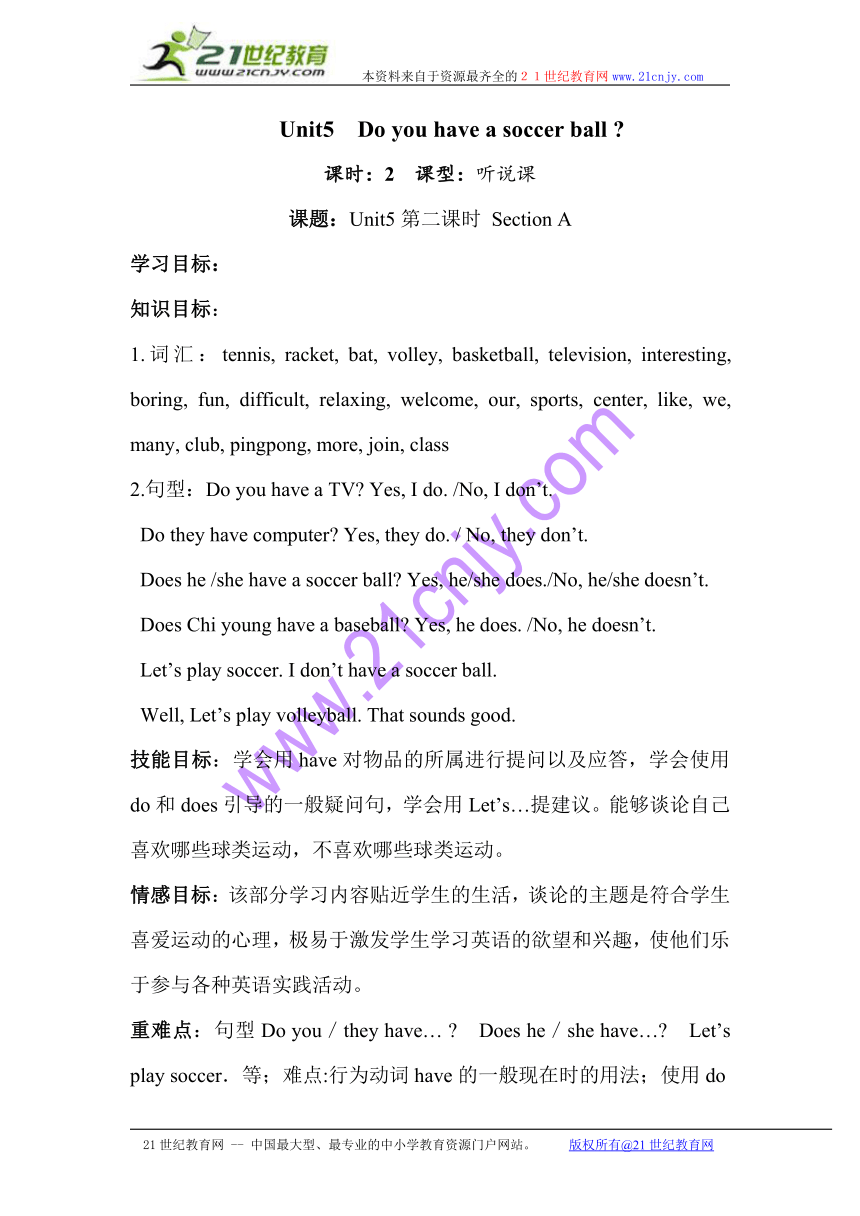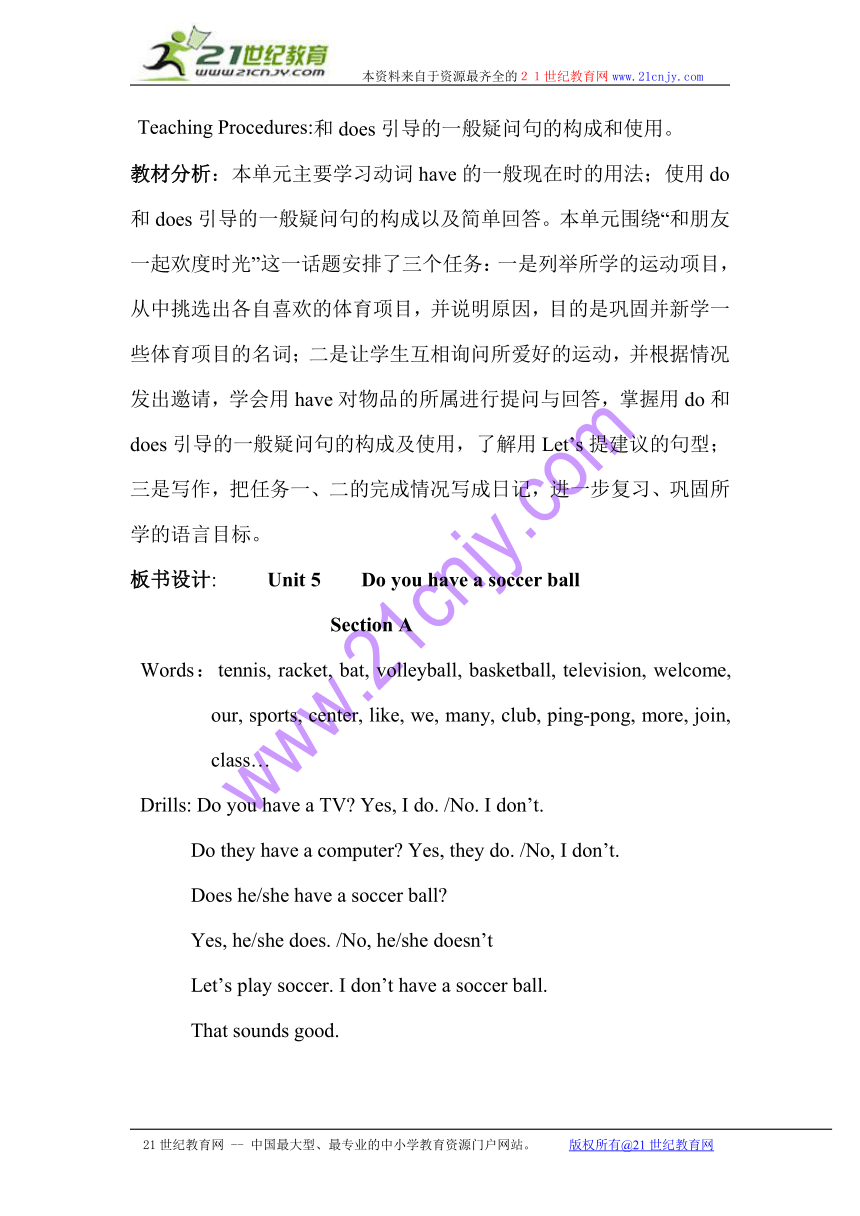Unit 5 Do you have a soccer ball?(Section A Period 2)
文档属性
| 名称 | Unit 5 Do you have a soccer ball?(Section A Period 2) |  | |
| 格式 | zip | ||
| 文件大小 | 14.9KB | ||
| 资源类型 | 教案 | ||
| 版本资源 | 人教新目标(Go for it)版 | ||
| 科目 | 英语 | ||
| 更新时间 | 2013-04-05 11:36:52 | ||
图片预览


文档简介
Unit5 Do you have a soccer ball ?
课时:2 课型:听说课
课题:Unit5第二课时 Section A
学习目标:
知识目标:
1.词汇:tennis, racket, bat, volley, basketball, television, interesting, boring, fun, difficult, relaxing, welcome, our, sports, center, like, we, many, club, pingpong, more, join, class
2.句型:Do you have a TV? Yes, I do. /No, I don’t.
Do they have computer? Yes, they do. / No, they don’t.
Does he /she have a soccer ball? Yes, he/she does./No, he/she doesn’t.
Does Chi young have a baseball? Yes, he does. /No, he doesn’t.
Let’s play soccer. I don’t have a soccer ball.
Well, Let’s play volleyball. That sounds good.
技能目标:学会用have对物品的所属进行提问以及应答,学会使用do和does引导的一般疑问句,学会用Let’s…提建议。能够谈论自己喜欢哪些球类运动,不喜欢哪些球类运动。
情感目标:该部分学习内容贴近学生的生活,谈论的主题是符合学生喜爱运动的心理,极易于激发学生学习英语的欲望和兴趣,使他们乐于参与各种英语实践活动。
重难点:句型Do you/they have… ? Does he/she have…? Let’s play soccer.等;难点:行为动词have的一般现在时的用法;使用do和does引导的一般疑问句的构成和使用。
教材分析:本单元主要学习动词have的一般现在时的用法;使用do和does引导的一般疑问句的构成以及简单回答。本单元围绕“和朋友一起欢度时光”这一话题安排了三个任务:一是列举所学的运动项目,从中挑选出各自喜欢的体育项目,并说明原因,目的是巩固并新学一些体育项目的名词;二是让学生互相询问所爱好的运动,并根据情况发出邀请,学会用have对物品的所属进行提问与回答,掌握用do和does引导的一般疑问句的构成及使用,了解用Let’s提建议的句型;三是写作,把任务一、二的完成情况写成日记,进一步复习、巩固所学的语言目标。
板书设计: Unit 5 Do you have a soccer ball
Section A
Words:tennis, racket, bat, volleyball, basketball, television, welcome, our, sports, center, like, we, many, club, ping-pong, more, join, class…
Drills: Do you have a TV? Yes, I do. /No. I don’t.
Do they have a computer? Yes, they do. /No, I don’t.
Does he/she have a soccer ball?
Yes, he/she does. /No, he/she doesn’t
Let’s play soccer. I don’t have a soccer ball.
That sounds good.
Teaching Procedures:
Step 1. Warming up
Greetings .
Free talk. eg. T:I have a brother. Do you have a brother?
Ss:Yes, I do./No, I don`t.
T:I have a soccer ball. Do you have a soccer ball?
Ss:Yes, I do./No, I don`t.
设计意图:巩固上节课的对话和单词。
Step 2 Presetation
1.Teach the new words about sports by using some pictures:I have a soccer ball/basketball/volleyball/tennis ball/ping-pong ball/baseball. Ask the Ss:Do you have a soccer ball/…? Ask the other Ss:Does he/she have…? Ss :Yes, he/she does./No, he/she doesn`t. T: Do they have…? Ss; Yes, they do./No, they don`t.
2.Pair work: Let the Ss ask and answer in pairs using the drills.(1c)
3.1a.let the Ss match the words with the things in the picture.
设计意图:利用图片和已学过的句型导入新课;利用直观形体语言、动作、语境教等单词,激发学生思维,帮助学生理解和记忆生词。
Step3 .Listening :
1.1b.Play the tape for the Ss to listen and circle the words they hear.Then
check their answers.
2.Play the tape again for the Ss to listen and repeat.
3.2a and 2b. Play the tape and let the Ss listen and number the pictures.
Check their answers on the Bb.
设计意图:训练学生听力,将单词和图片结合起来。
Step3 Practice
1.2c.Let the Ss ask and answer questions about the people in 2a. eg.
Do you have…?Yes,I do/No.I don’t.
Does he/she…?Yes.he/she does/No,he/she doesn’t.
2.2d.Play the tape for the Ss to listen and repeat.Then let them read in groups .Finally let some Ss act out the conversation.
设计意图:根据图画内容运用动词have进行询问所属,以练习由助动词do/does引导的一般疑问句结构。
Step 4 Grammar focus
1.Let the Ss read the grammar focus .Make sure the understand the meaning .
2.Let the Ss finish 3a and 3b.Then check the answers with the whole class设计意图:.让学生在理解语法的基础上巩固运用语法,学会使用助动词do/does。
Step 5 Exx.
用所给词的适当形式填空。
1.The boy (have ) some videos.
2.He (not have ) basketball.
3. (do) she like playing basket?
4.My parents (not have) many books.
5. (do) you watch TV every day ?
设计意图:培养学生的写的能力。由口头训练转向笔头训练,单句的练习为下一步的篇章书写打下基础。
Step 6 Homework:
1.Remember the words and expressions in Section A .
2.Finish exercises in workbook.
教学反思:
本课利用实物、教学幻灯片或图片等来展开课堂Pairwork问答式的口语交际活动,通过使用have对物品的所属进行提问及回答,使学生学会使用do和does引导的一般疑问句以及肯定和否定回答。通过本课的学习使学生能够谈论自己喜欢哪些球类运动,不喜欢哪些球类运动。本课重在对学生进行听力和口语交际能力的训练,同时进行了一点书面训练,有利于学生巩固掌握。
不足:没能够做到知识的迁移,使所学知识生活化(如可以相互询问运动用品的持有情况)
课时:2 课型:听说课
课题:Unit5第二课时 Section A
学习目标:
知识目标:
1.词汇:tennis, racket, bat, volley, basketball, television, interesting, boring, fun, difficult, relaxing, welcome, our, sports, center, like, we, many, club, pingpong, more, join, class
2.句型:Do you have a TV? Yes, I do. /No, I don’t.
Do they have computer? Yes, they do. / No, they don’t.
Does he /she have a soccer ball? Yes, he/she does./No, he/she doesn’t.
Does Chi young have a baseball? Yes, he does. /No, he doesn’t.
Let’s play soccer. I don’t have a soccer ball.
Well, Let’s play volleyball. That sounds good.
技能目标:学会用have对物品的所属进行提问以及应答,学会使用do和does引导的一般疑问句,学会用Let’s…提建议。能够谈论自己喜欢哪些球类运动,不喜欢哪些球类运动。
情感目标:该部分学习内容贴近学生的生活,谈论的主题是符合学生喜爱运动的心理,极易于激发学生学习英语的欲望和兴趣,使他们乐于参与各种英语实践活动。
重难点:句型Do you/they have… ? Does he/she have…? Let’s play soccer.等;难点:行为动词have的一般现在时的用法;使用do和does引导的一般疑问句的构成和使用。
教材分析:本单元主要学习动词have的一般现在时的用法;使用do和does引导的一般疑问句的构成以及简单回答。本单元围绕“和朋友一起欢度时光”这一话题安排了三个任务:一是列举所学的运动项目,从中挑选出各自喜欢的体育项目,并说明原因,目的是巩固并新学一些体育项目的名词;二是让学生互相询问所爱好的运动,并根据情况发出邀请,学会用have对物品的所属进行提问与回答,掌握用do和does引导的一般疑问句的构成及使用,了解用Let’s提建议的句型;三是写作,把任务一、二的完成情况写成日记,进一步复习、巩固所学的语言目标。
板书设计: Unit 5 Do you have a soccer ball
Section A
Words:tennis, racket, bat, volleyball, basketball, television, welcome, our, sports, center, like, we, many, club, ping-pong, more, join, class…
Drills: Do you have a TV? Yes, I do. /No. I don’t.
Do they have a computer? Yes, they do. /No, I don’t.
Does he/she have a soccer ball?
Yes, he/she does. /No, he/she doesn’t
Let’s play soccer. I don’t have a soccer ball.
That sounds good.
Teaching Procedures:
Step 1. Warming up
Greetings .
Free talk. eg. T:I have a brother. Do you have a brother?
Ss:Yes, I do./No, I don`t.
T:I have a soccer ball. Do you have a soccer ball?
Ss:Yes, I do./No, I don`t.
设计意图:巩固上节课的对话和单词。
Step 2 Presetation
1.Teach the new words about sports by using some pictures:I have a soccer ball/basketball/volleyball/tennis ball/ping-pong ball/baseball. Ask the Ss:Do you have a soccer ball/…? Ask the other Ss:Does he/she have…? Ss :Yes, he/she does./No, he/she doesn`t. T: Do they have…? Ss; Yes, they do./No, they don`t.
2.Pair work: Let the Ss ask and answer in pairs using the drills.(1c)
3.1a.let the Ss match the words with the things in the picture.
设计意图:利用图片和已学过的句型导入新课;利用直观形体语言、动作、语境教等单词,激发学生思维,帮助学生理解和记忆生词。
Step3 .Listening :
1.1b.Play the tape for the Ss to listen and circle the words they hear.Then
check their answers.
2.Play the tape again for the Ss to listen and repeat.
3.2a and 2b. Play the tape and let the Ss listen and number the pictures.
Check their answers on the Bb.
设计意图:训练学生听力,将单词和图片结合起来。
Step3 Practice
1.2c.Let the Ss ask and answer questions about the people in 2a. eg.
Do you have…?Yes,I do/No.I don’t.
Does he/she…?Yes.he/she does/No,he/she doesn’t.
2.2d.Play the tape for the Ss to listen and repeat.Then let them read in groups .Finally let some Ss act out the conversation.
设计意图:根据图画内容运用动词have进行询问所属,以练习由助动词do/does引导的一般疑问句结构。
Step 4 Grammar focus
1.Let the Ss read the grammar focus .Make sure the understand the meaning .
2.Let the Ss finish 3a and 3b.Then check the answers with the whole class设计意图:.让学生在理解语法的基础上巩固运用语法,学会使用助动词do/does。
Step 5 Exx.
用所给词的适当形式填空。
1.The boy (have ) some videos.
2.He (not have ) basketball.
3. (do) she like playing basket?
4.My parents (not have) many books.
5. (do) you watch TV every day ?
设计意图:培养学生的写的能力。由口头训练转向笔头训练,单句的练习为下一步的篇章书写打下基础。
Step 6 Homework:
1.Remember the words and expressions in Section A .
2.Finish exercises in workbook.
教学反思:
本课利用实物、教学幻灯片或图片等来展开课堂Pairwork问答式的口语交际活动,通过使用have对物品的所属进行提问及回答,使学生学会使用do和does引导的一般疑问句以及肯定和否定回答。通过本课的学习使学生能够谈论自己喜欢哪些球类运动,不喜欢哪些球类运动。本课重在对学生进行听力和口语交际能力的训练,同时进行了一点书面训练,有利于学生巩固掌握。
不足:没能够做到知识的迁移,使所学知识生活化(如可以相互询问运动用品的持有情况)
同课章节目录
- starters 预备篇(2012秋审查)
- Unit 1 Good morning !
- Unit 2 What’s this in English?
- Unit 3 What color is it ?
- Unit 1 My name's Gina.
- Section A
- Section B
- Unit 2 This is my sister.
- Section A
- Section B
- Unit 3 Is this your pencil?
- Section A
- Section B
- Unit 4 Where's my schoolbag?
- Section A
- Section B
- Unit 5 Do you have a soccer ball?
- Section A
- Section B
- Unit 6 Do you like bananas?
- Section A
- Section B
- Unit 7 How much are these socks?
- Section A
- Section B
- Unit 8 When is your birthday?
- Section A
- Section B
- Unit 9 My favorite subject is science.
- Section A
- Section B
